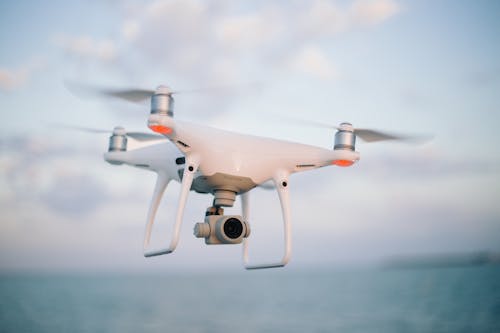
Drone technology has evolved rapidly over the past decade, moving from niche hobbyist gadgetry to a central component in various industries worldwide. As technological advancements continue, the potential applications of drones are expanding, promising to revolutionize how we conduct business, provide services, and explore new frontiers. This article delves into the current state of drone technology, explores its diverse applications, and envisions the future impact drones will have on our world.
The Evolution of Drone Technology
Early Beginnings and Technological Advancements
The concept of unmanned aerial vehicles (UAVs), commonly known as drones, has been around for over a century. Early uses were primarily military, with the first drones deployed for reconnaissance and combat missions. However, technological advancements in the late 20th and early 21st centuries have expanded the capabilities and accessibility of drones, making them useful in civilian applications.
Key technological advancements include:
- Miniaturization: Smaller, more efficient components have allowed for lightweight, agile drones.
- Battery Technology: Improved battery life extends operational time.
- Autonomous Navigation: Advanced GPS and AI systems enable drones to navigate independently.
- Enhanced Sensors: High-resolution cameras, thermal imaging, and LiDAR sensors have expanded the range of applications.
Regulatory Frameworks
As drones became more prevalent, governments worldwide have developed regulatory frameworks to ensure safe and responsible use. These regulations address issues such as airspace management, privacy, and safety standards. For instance, the Federal Aviation Administration (FAA) in the United States requires drone operators to obtain certifications and adhere to specific operational guidelines.
Current Applications of Drone Technology
Agriculture: Precision Farming
Drones are transforming agriculture by enabling precision farming practices. Equipped with various sensors, drones can monitor crop health, soil conditions, and water levels, providing farmers with valuable data to optimize their practices. Key benefits include:
- Crop Monitoring: Drones capture high-resolution images to identify issues such as pest infestations, disease outbreaks, and nutrient deficiencies.
- Efficient Spraying: Drones can be used for targeted spraying of pesticides and fertilizers, reducing waste and environmental impact.
- Soil Analysis: Drones equipped with multispectral sensors analyze soil conditions, helping farmers manage irrigation and nutrient application more effectively.
Infrastructure: Inspection and Maintenance
Drones are becoming indispensable tools for inspecting and maintaining infrastructure. They offer a safer and more efficient alternative to traditional methods, particularly for hard-to-reach areas. Applications include:
- Bridge Inspections: Drones equipped with high-resolution cameras and thermal sensors inspect bridges for structural integrity and detect issues like cracks and corrosion.
- Power Line Monitoring: Drones survey power lines, identifying potential hazards such as vegetation encroachment and equipment malfunctions.
- Construction Site Monitoring: Drones provide real-time progress updates, ensuring projects stay on schedule and within budget.
Environmental Conservation: Monitoring and Protection
Drones play a crucial role in environmental conservation efforts, providing researchers and conservationists with valuable data to protect ecosystems and wildlife. Key uses include:
- Wildlife Monitoring: Drones track animal populations, monitor migration patterns, and observe behavior without disturbing habitats.
- Forest Management: Drones assess forest health, detect illegal logging, and monitor reforestation efforts.
- Disaster Response: Drones survey areas affected by natural disasters, such as floods, hurricanes, and wildfires, providing real-time data for effective response and recovery.
Healthcare: Delivery and Emergency Response
Drones are poised to revolutionize healthcare delivery, particularly in remote and underserved areas. They offer a fast and efficient means of transporting medical supplies and providing emergency response services. Applications include:
- Medical Supply Delivery: Drones deliver essential medical supplies, such as vaccines, medications, and blood, to remote or disaster-stricken areas.
- Emergency Response: Drones equipped with first aid kits, defibrillators, and communication devices provide immediate assistance in emergencies.
- Search and Rescue: Drones with thermal imaging and GPS capabilities locate missing persons and provide situational awareness to rescue teams.
E-Commerce and Logistics: Revolutionizing Delivery Services
The e-commerce and logistics industries are experiencing a significant transformation thanks to drone technology. Companies like Amazon and UPS are exploring the use of drones for last-mile delivery services, promising faster and more efficient deliveries. Key advantages include:
- Speed and Efficiency: Drones can bypass traffic and deliver packages directly to customers’ doorsteps, reducing delivery times.
- Cost Savings: Automated drone deliveries reduce labor costs and operational expenses.
- Environmental Impact: Drones produce fewer emissions compared to traditional delivery vehicles, contributing to greener logistics practices.
Future Prospects of Drone Technology
Urban Air Mobility: The Rise of Drone Taxis
One of the most exciting future prospects of drone technology is urban air mobility (UAM). Companies like Uber and Airbus are developing drone taxis to transport passengers within cities, potentially revolutionizing urban transportation. Benefits include:
- Reduced Traffic Congestion: Drone taxis can alleviate road traffic by utilizing airspace for transportation.
- Time Savings: Passengers can reach their destinations faster by avoiding traffic delays.
- Environmental Benefits: Electric-powered drone taxis produce fewer emissions compared to traditional vehicles.
Advanced AI and Autonomous Operations
The integration of artificial intelligence (AI) and machine learning will further enhance the capabilities of drones. Advanced AI algorithms enable drones to perform complex tasks autonomously, improving efficiency and safety. Future applications include:
- Autonomous Inspections: AI-powered drones can autonomously inspect infrastructure, identify issues, and perform maintenance tasks.
- Smart Agriculture: AI algorithms analyze drone-collected data to provide precise recommendations for crop management.
- Disaster Management: AI-driven drones can predict natural disasters, monitor affected areas, and coordinate emergency response efforts.
Drones in Space Exploration
Drones are not limited to Earth-based applications; they are also poised to play a crucial role in space exploration. NASA and other space agencies are developing drones to explore distant planets and moons. Key projects include:
- Mars Exploration: NASA’s Ingenuity helicopter drone successfully completed multiple flights on Mars, providing valuable data for future missions.
- Lunar Missions: Drones are being designed to explore the Moon’s surface, conducting geological surveys and searching for resources.
- Asteroid Mining: Drones could be used to survey and extract valuable minerals from asteroids, opening new possibilities for space resources.
Enhanced Security and Surveillance
The security and surveillance sectors are expected to see significant advancements with drone technology. Future applications include:
- Border Security: Drones equipped with advanced sensors and AI capabilities can monitor borders for illegal activities and provide real-time alerts.
- Public Safety: Drones can assist law enforcement agencies in monitoring large events, tracking suspects, and responding to emergencies.
- Critical Infrastructure Protection: Drones can monitor and secure critical infrastructure, such as power plants, water facilities, and transportation networks.
Challenges and Considerations
Regulatory and Ethical Concerns
As drone technology advances, regulatory and ethical concerns must be addressed to ensure safe and responsible use. Key challenges include:
- Privacy Issues: Drones equipped with cameras and sensors raise concerns about privacy and data security. Clear regulations are needed to protect individuals’ privacy rights.
- Airspace Management: Integrating drones into existing airspace systems requires careful planning to prevent collisions and ensure safe operations.
- Ethical Use: The potential misuse of drones for surveillance, warfare, and other unethical purposes must be addressed through international agreements and stringent regulations.
Technological Limitations
Despite significant advancements, drone technology still faces several limitations that must be overcome for widespread adoption:
- Battery Life: Limited battery life restricts the operational range and duration of drones. Research into more efficient power sources is essential.
- Weather Conditions: Drones are vulnerable to adverse weather conditions, such as strong winds, rain, and extreme temperatures, which can impact their performance.
- Payload Capacity: The payload capacity of drones is limited, affecting their ability to carry heavy or bulky items.
Public Acceptance
The successful integration of drones into society depends on public acceptance. Educating the public about the benefits and safety measures of drone technology is crucial to addressing concerns and fostering positive attitudes.

Conclusion: Embracing the Drone Revolution
Drone technology is poised to revolutionize numerous industries and aspects of daily life, offering unprecedented opportunities for innovation, efficiency, and progress. From precision farming and infrastructure inspection to healthcare delivery and urban air mobility, the potential applications of drones are vast and varied.
As we look to the future, it is essential to address regulatory, ethical, and technological challenges to ensure the responsible and sustainable development of drone technology. By embracing this revolutionary technology and harnessing its capabilities, we can create a more connected, efficient, and prosperous world.
In conclusion, the future of drone technology is bright, with endless possibilities waiting to be explored. Young people, entrepreneurs, and industry leaders must work together to drive innovation, overcome challenges, and unlock the full potential of drones, transforming our world in ways we have only begun to imagine.














